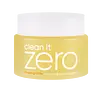What's inside
What's inside
 Key Ingredients
Key Ingredients

 Benefits
Benefits

 Concerns
Concerns

 Ingredients Side-by-side
Ingredients Side-by-side

Ethylhexyl Stearate
EmollientPEG-20 Glyceryl Triisostearate
EmollientPEG-10 Isostearate
EmulsifyingSynthetic Wax
AbrasiveCarthamus Tinctorius Seed Oil
MaskingPolyglyceryl-2 Triisostearate
EmulsifyingButylene Glycol
HumectantWater
Skin ConditioningParfum
MaskingGlyceryl Caprylate
EmollientCaprylyl Glycol
EmollientPanax Ginseng Root Extract
EmollientPanax Ginseng Berry Extract
Skin ConditioningButyrospermum Parkii Butter
Skin ConditioningSimmondsia Chinensis Seed Oil
EmollientOnsen-Sui
1,2-Hexanediol
Skin ConditioningChenopodium Quinoa Seed Extract
Skin ConditioningPanax Ginseng Root Water
MaskingTheobroma Cacao Extract
Skin ConditioningDextrin
AbsorbentGlycine Max Polypeptide
Skin ConditioningLactobacillus Ferment
Skin ConditioningAvena Sativa Meal Extract
SoothingPanax Ginseng Seed Oil
EmollientLactobacillus
Skin ConditioningHydrolyzed Ginseng Saponins
Skin ConditioningEthylhexyl Stearate, PEG-20 Glyceryl Triisostearate, PEG-10 Isostearate, Synthetic Wax, Carthamus Tinctorius Seed Oil, Polyglyceryl-2 Triisostearate, Butylene Glycol, Water, Parfum, Glyceryl Caprylate, Caprylyl Glycol, Panax Ginseng Root Extract, Panax Ginseng Berry Extract, Butyrospermum Parkii Butter, Simmondsia Chinensis Seed Oil, Onsen-Sui, 1,2-Hexanediol, Chenopodium Quinoa Seed Extract, Panax Ginseng Root Water, Theobroma Cacao Extract, Dextrin, Glycine Max Polypeptide, Lactobacillus Ferment, Avena Sativa Meal Extract, Panax Ginseng Seed Oil, Lactobacillus, Hydrolyzed Ginseng Saponins
Water
Skin ConditioningGlycerin
HumectantMyristic Acid
CleansingPotassium Hydroxide
BufferingLauric Acid
CleansingLaureth-7
EmulsifyingPalmitic Acid
EmollientGlycol Distearate
EmollientGlycol Stearate
EmollientPEG-8
HumectantSodium Methyl Stearoyl Taurate
CleansingSorbitan Olivate
EmulsifyingButylene Glycol
HumectantPanax Notoginseng Root Extract
HumectantParfum
MaskingTocopheryl Acetate
AntioxidantDisodium EDTA
Hydroxyethylcellulose
Emulsion StabilisingMalpighia Glabra Fruit Extract
Skin ConditioningAspalathus Linearis Leaf Extract
Skin ConditioningCI 14700
Cosmetic ColorantWater, Glycerin, Myristic Acid, Potassium Hydroxide, Lauric Acid, Laureth-7, Palmitic Acid, Glycol Distearate, Glycol Stearate, PEG-8, Sodium Methyl Stearoyl Taurate, Sorbitan Olivate, Butylene Glycol, Panax Notoginseng Root Extract, Parfum, Tocopheryl Acetate, Disodium EDTA, Hydroxyethylcellulose, Malpighia Glabra Fruit Extract, Aspalathus Linearis Leaf Extract, CI 14700
 Reviews
Reviews

Ingredients Explained
These ingredients are found in both products.
Ingredients higher up in an ingredient list are typically present in a larger amount.
Butylene Glycol (or BG) is used within cosmetic products for a few different reasons:
Overall, Butylene Glycol is a safe and well-rounded ingredient that works well with other ingredients.
Though this ingredient works well with most skin types, some people with sensitive skin may experience a reaction such as allergic rashes, closed comedones, or itchiness.
Learn more about Butylene GlycolParfum is a catch-all term for an ingredient or more that is used to give a scent to products.
Also called "fragrance", this ingredient can be a blend of hundreds of chemicals or plant oils. This means every product with "fragrance" or "parfum" in the ingredients list is a different mixture.
For instance, Habanolide is a proprietary trade name for a specific aroma chemical. When used as a fragrance ingredient in cosmetics, most aroma chemicals fall under the broad labeling category of “FRAGRANCE” or “PARFUM” according to EU and US regulations.
The term 'parfum' or 'fragrance' is not regulated in many countries. In many cases, it is up to the brand to define this term.
For instance, many brands choose to label themselves as "fragrance-free" because they are not using synthetic fragrances. However, their products may still contain ingredients such as essential oils that are considered a fragrance by INCI standards.
One example is Calendula flower extract. Calendula is an essential oil that still imparts a scent or 'fragrance'.
Depending on the blend, the ingredients in the mixture can cause allergies and sensitivities on the skin. Some ingredients that are known EU allergens include linalool and citronellol.
Parfum can also be used to mask or cover an unpleasant scent.
The bottom line is: not all fragrances/parfum/ingredients are created equally. If you are worried about fragrances, we recommend taking a closer look at an ingredient. And of course, we always recommend speaking with a professional.
Learn more about ParfumWater. It's the most common cosmetic ingredient of all. You'll usually see it at the top of ingredient lists, meaning that it makes up the largest part of the product.
So why is it so popular? Water most often acts as a solvent - this means that it helps dissolve other ingredients into the formulation.
You'll also recognize water as that liquid we all need to stay alive. If you see this, drink a glass of water. Stay hydrated!
Learn more about Water